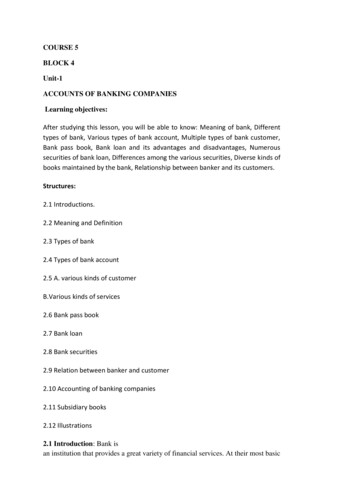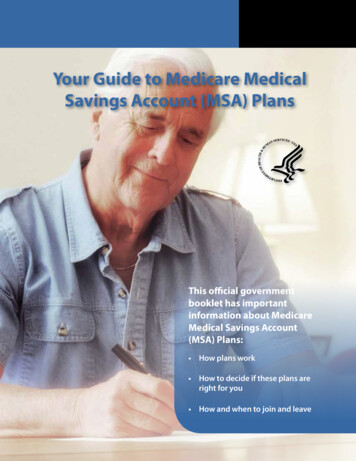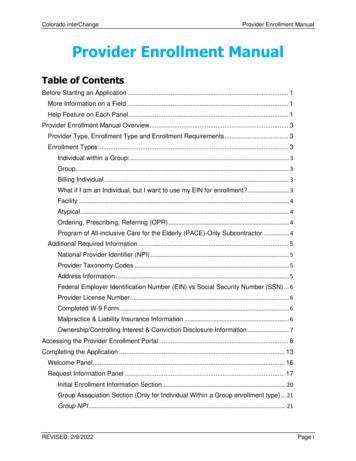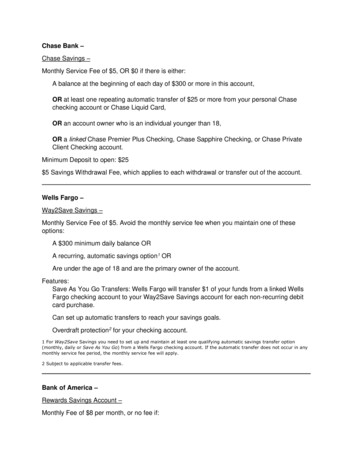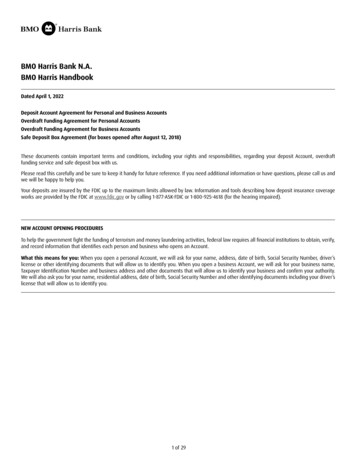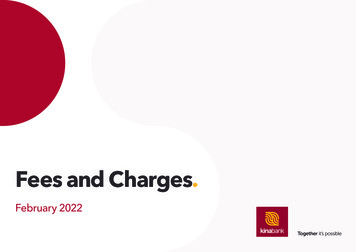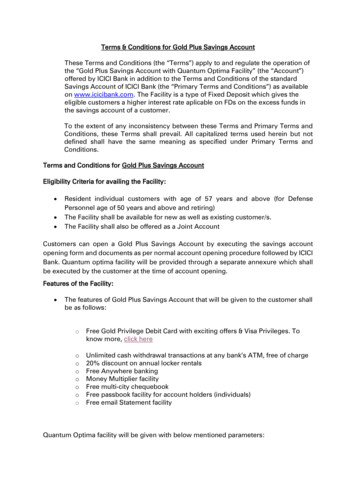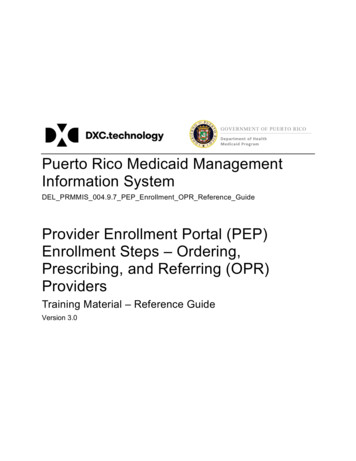
Transcription
Health Savings Account Enrollment Bookletfor Individuals and FamiliesTake Charge of Your HealthYour Money And Your Future
Take Chargeof Your Health,Your Money andYour FutureWould you like to have more controlover your health care dollars?Pay for current and future healthexpenses with tax-free dollars?Save money for your future healthcare costs?With the new health savings account (HSA) from Wells Fargo and compatiblehigh-deductible health plan (HDHP), you can do it all! Flexible, affordable andeasy to use, an HSA is a tax-advantaged* account that empowers you to takecharge of your health, your money and your future.HSA BenefitsMore control over your health care dollarsYou’re in charge of your health shouldn’t you be in charge of how you spend your health care dollars, too?With an HSA, you are. Your HSA works in conjunction with a compatible high-deductible health plan. You decide how much money(up to certain limits) you want to contribute each year. Higher contribution limits, allowable catch-up contributions and the ability tosave money for future health care expenses make the HSA more flexible than other tax-advantaged accounts, such as medicalsavings accounts (MSAs), flexible spending accounts (FSAs) and health reimbursement arrangements (HRAs).Your health coverage provider has selected Wells Fargo, one of the nation’s leading financial institutions, to be the preferredfinancial services company to administer HSAs for eligible individuals. Wells Fargo holds your HSA contributions exclusively for yourbenefit, ready for you to use whenever you have qualified health care expenses to pay for you, your spouse or yourdependent children.*All tax references are at the federal level. State taxes vary. Please consult with your tax advisor.
With an HSA, you decide: How much to contribute(within certain limits) How much to use for healthcare expenses Which health care expenses to payfrom the accountTax savingsWho doesn’t appreciate a tax-free way to pay — and save?With a Wells Fargo HSA, your contributions, earnings and eligiblewithdrawals are all tax-free. You can deduct the money you contribute toan HSA on your federal tax return, even if you don’t itemize deductions.As long as your withdrawals are used to pay for qualified health careexpenses, you won’t pay taxes on them. You must keep supportingreceipts and records to show the Internal Revenue Serviceyou used the funds to pay qualified health care expenses. Whether to pay for health careexpenses from the account or save theaccount for future use What type of investments to growyour accountLong-term savingsAn HSA covers more than your health expenses today it helps you plan for the future, too.Just like an IRA or 401(k), you have the opportunity to make your HSA grow by investing your contributionsin your choice of Wells Fargo investment funds. You can choose from a variety of mutual fund investmentoptions — from conservative to aggressive — to match your personal financial goals and investment style.And with Wells Fargo’s flexible account access, you can change your investment fund elections at any time.Best of all, your unused account balance rolls over from year to year. Accumulated funds in your HSA growtax-free, so you can save for future health care expenses.ConvenienceNeed new eyeglasses? Need to visit your health care provider for a sports injury?From doctor visits to prescription drugs, you can use the money in your HSA to pay for a variety of healthcare-related expenses — and with the Wells Fargo HSA, payment is easy and convenient. Wells Fargo offersonline account management, so you can review your account information 24 hours a day, seven days aweek. You can also use our toll-free telephone service and speak with customer service representativesbetween 7 a.m. and 8 p.m. CST Monday – Friday.OwnershipNo one knows what your family’s future may bring — job changes,new health plans, perhaps an out-of-state move.With an HSA, you don’t have to worry — your account is entirely ownedby you. Your account balance is yours to take with you wherever you go.Tax-free savingsYour unused HSA balance rolls overfrom year to year. The contributions andinvestment gains you make continue togrow and can be used tax-free for qualifiedhealth care expenses later in life, whenyour health care needs may be greater.
How Does an HSA Work?Consider the following examples:Ben’s health plan features:Family coverage:Maximum out-of-pocket: 2,000 deductible 10,200Ben enrolled in an HSA-eligible high-deductible health planBen’s coverage:in January with family coverage for himself, his wife and his twochildren. His deductible is 2,000, so his HSA contributions cannotexceed 2,000 for the year. Ben decides to contribute 2,000 intohis HSA.Coinsurance coverage:Employee pays:In-network80%20%Preventive care:Pharmacy coverage:100% coverage (deductible does not apply)subject to deductibleOut-of-network70%30%Alicia’s health plan features:Alicia enrolled in an HSA-eligible high-deductible health planin January with individual coverage for herself. Her deductible is 2,600, so her HSA contributions cannot exceed 2,600 for the year.Alicia decides to contribute 2,600 into her HSA.BenIndividual coverage:Maximum out-of-pocket: 2,600 deductible 5,100Alicia’s coverage:Coinsurance coverage:Employee pays:In-network80%20%Preventive care:Pharmacy coverage:100% coverage (deductible does not apply)subject to deductibleOut-of-network70%30%Amount inBen’s HSAAmount Benpays fromhis HSAAmountpaid by Ben’shealth planBen’s remainingout-of-pocketexpenseAmount left inBen’s HSA to carryover to next year 2,000 2,000 2,560 640 0 2,000 1,200 0 0 800(plus earnings)Amount inAlicia’s HSAAmount Aliciapays fromher HSAAmountpaid by Alicia’shealth planAlicia’s remainingout-of-pocketexpenseAmount left inAlicia’s HSA to carryover to next year 2,600 600 0 400 2,000(plus earnings) 2,600 0 0 0 2,600(plus earnings)Scenario 1During the year, Ben and his family have in-network health care expenses of 5,200 that are not considered preventive care. Ben chooses to pay these expensesfrom the balance in his HSA. Because his deductible is 2,000, the health plancovers 80% of the remaining 3,200, or 2,560. This leaves 640 (20%) as Ben’sout-of-pocket expense.Scenario 2During the year, Ben and his family have in-network health care expenses of 1,200 that are not considered preventive care. Since his total expenses are lessthan his deductible, Ben is responsible for all the expenses. Ben chooses to paythese expenses from the balance in his HSA.AliciaScenario 1During the year, Alicia has in-network health care expenses of 1,000 that arenot considered preventive care. Because her deductible is 2,600, Alicia isresponsible for all of these costs. She chooses to pay only 600 of these expensesfrom the balance in her HSA, because she wants to start saving for her futurehealth care needs.Scenario 2Alicia is very healthy during the year and has no health care expenses except forregular checkups and screenings, which are all considered preventive care. Sinceher plan covers preventive care at 100% and it does not apply to her deductible,Alicia is able to carry over her entire 2,600 HSA balance into the next year.* These examples are for illustrative purposes only. Individual situations will vary depending on the specifics of your HDHP and your individual contributions.
Using Your HSAPaying for health care expenses is easy with theWells Fargo Health Savings Account.When you pick up a prescription or need to pay for other qualified health care expenses, simply use yourcard.* Your card works at all eligible providers that accept Visa debit cards.** As long as you have thenecessary funds in your account, there’s no need to pay co-payments or other expenses out of pocket, andno need to submit manual claims forms for reimbursement. If you choose not to use the card, you cansubmit a reimbursement request by mail or toll-free fax and be reimbursed within 7 to 10 business days.* To ensure that all of your health insurance carrier’s reductions are applied to your provider’s charges, you may want to use your card to pay thebalance due on your provider’s final invoice rather than at the time of your appointment.** Provider acceptance and billing methods may vary.Eligibility:To be eligible to make a tax-deductiblecontribution to an HSA, you must beenrolled in an HSA-eligible high-deductiblehealth plan (HDHP) offered by your healthinsurance provider. A HDHP is a comprehensive health planwith an annual deductible of at least 1,000 for an individual and 2,000 fortwo or more family members. The annualout-of-pocket expenses in the HDHPcannot exceed 5,100 for an individualand 10,200 for a family (amountsindexed for inflation). You cannot have any other healthinsurance coverage that is not subject tothe HDHP limits except worker’scompensation, property insurance,insurance for a specific disease (such ascancer coverage), insurance that pays afixed amount per day of hospitalization,dental, vision, long-term care, accidentsand disability. You cannot be enrolled in Medicare orbe a dependent on another person’stax return. You cannot have received VA medicalbenefits at any time over the pastthree months.Qualified Health Care ExpensesThe money in your HSA can be used for qualified health care expenses foryourself, your spouse or your dependent children, even if your spouse anddependents are not covered by the same high-deductible health plan. Qualifiedhealth care expenses include co-payments and deductibles at doctors,pharmacies, medical labs, dentists and orthodontists, medical supply stores,chiropractors, hospitals, vision centers, podiatrists and more.You can also use HSA funds for eyeglasses and contact lenses, mail orderprescriptions, online prescriptions and eligible over-the-counter (OTC)medications and bills from providers for “Patient Balance Due” amounts. For acomplete listing of IRS-allowable health care expenses, visit our Web site andfollow the links to the list of IRS-qualified expenses.Best of all, the money in your HSA can be used to pay for eligible out-of-pockethealth care expenses now — or in the future. The choice is yours — foreach expense, you can pay from your HSA or save the money in youraccount for future health care expenses. If you use funds from your HSA to pay for something other than aqualified health care expense, you will be required to pay income tax anda ten percent additional tax on that amount unless you are disabled orage 65 or older. You will need to include that amount as regular incomewhen you file your taxes.
Discovering Financial HealthYour Wells Fargo HSA can be a powerful tool for helping you save and invest for your futurehealth care expenses.Every year, you decide how much to set aside for your health care expenses and then whether to pay foryour health care expenses from your HSA or save the money in your account for future use. The unusedmoney in your account plus earnings roll over from year to year, helping you build your future health carenest egg.While the many ins and outs of investing could fill volumes, you don’t have to know it all to get started. Infact, there are just a few basics you’ll need to know to get enrolled in your HSA. And, if you’re alreadyfamiliar with investing in a 401(k), choosing investments for your HSA works the verysame way.Investments offered by your planHSA investments are made through mutual trust funds that generally fall into thesecategories: money market, fixed income, stock or asset allocation.What is a mutual fund?A mutual fund is a collection of many individual investments — money market, fixedincome and stock — managed by a professional fund manager.Mutual funds have different goalsMutual funds pool the money of investors with common — or mutual — goals.Which mutual fund you choose to invest in will depend largely on your investmentgoals. Some mutual funds hold only one type of investment — a stock fund, for instance, holds stock, andmight have the goal of growing investors’ money as much as possible. Other mutual funds hold a varietyof stock, fixed income and money market investments, and might have the goal of providing investorswith a steady stream of income.All investments carry riskAll investments carry a certain amount of risk, and some investments are more risky than others. In mostcases, the greater the risk a particular investment carries, the greater its potential return. The ratio of aninvestment’s potential risk to its potential for return is called its risk/return profile.UNDERSTANDING RISKStockMoney MarketMoney market, or “cashequivalent” funds can bequickly turned into cashwithout losing much, if any, oftheir principal value. Moneymarket funds typically includecertificates of deposit (CDs),money market funds, and U.S.Treasury Bills.LOWRISKRISK / RETURN PROFILEHIGHRISKMEDIUMRISKFixed IncomeFixed income investments usually refer to bonds.When you buy a bond, you are lending money to acompany or government entity. Bonds are also calledfixed income investments because the issuerspromise to pay the investor a set amount of interest.When you buy stock, you arebuying a piece of ownershipin a company. Historically,stocks have provided thehighest return over the longterm. However, they alsotend to fluctuate in valuemore frequently than othertypes of investments.
After five years, Alicia from ourexample has saved more than 10,000 in her HSA for her futurehealth care expenses. She will alsobenefit from investment earningsand continues to review herinvestment choices regularly to helpreach her goal of paying for herhealth care in retirement.Mutual funds help you manage riskOne powerful way to manage risk is through diversification. Diversification is when you spread your moneyout among many different types of investments. Because mutual funds hold many individual securities,they give you the benefit of built-in diversification.When do you plan to use the money in your HSA?Your investment strategy should also depend on when you plan to use the money. Short-term investing(for example, you expect to use the money within the next year) generally calls for a conservativeinvestment strategy. Longer-term investing (for example, you plan to accumulate the money in your HSAfor future health care needs which may be more than five years away) could allow for a more moderate toaggressive investment strategy.Which funds are right for you?Once you understand the basics of investing, you’ll need to determine which funds are right for you. Thereis no magic formula; only you can determine which types of funds are right for your personal savings goals.
Featuresof Your Health Savings Account (HSA)An HSA is a tax-advantaged health savings account that allows you to set aside money to pay for eligible out-ofpocket health care expenses now or in the future. Here is what you need to know about your Wells Fargo HSA to takefull advantage of all the benefits it has to offer.ContributionsHow much can I contribute?A deposit of 100 is needed to open your Wells FargoHSA. Yearly maximum contribution levels are set by thefederal government. For 2005, you can contribute moneyup to either the amount of the deductible for your HDHPor 2,650 for an individual or 5,250 for a family,whichever is less. You may contribute to your accountuntil the April 15 tax deadline following the year forwhich you want to make contributions.What if I am not covered by an HDHP for thewhole year?Contribution maximums are based upon the number ofmonths that you are eligible to make an HSAcontribution. If your annual deductible is 1,200, you cancontribute 100 for each month in the calendar year thatyou are enrolled in an HDHP and otherwise meet theeligibility requirements. If you are eligible to make acontribution for three months, then your contributionlimit would be 300. You could make this contribution atany time during the year up to as late as April 15 of thenext year.How can contributions be credited to my HSA?You or others can make lump-sum contributions of anyamount at any time, up to the deductible for your HDHPor the maximum limit, whichever is less. Use the HSAContribution and Rollover Form* to make a deposit toyour Health Savings Account.Can my spouse and I both establish an HSA?Yes. If both you and your spouse individually meet thecriteria for making an HSA contribution, you can bothmake HSA contributions. However, if both you and yourspouse are covered by the same family coverage, you willneed to allocate the HSA contribution limit between thetwo of you. If you and your spouse have separateinsurance coverage, then each of you will need tocalculate your own HSA limit and open separate HSAs.Separate insurance coverage means that your insurancedoesn't cover your spouse and your spouse's insurancedoesn't cover you.* This and other forms are available online at www.wfhbs.com/hsa or by calling our customer service representatives at866-890-8309 between 7 a.m. and 8 p.m. CST Monday - Friday.
Can I make catch-up contributions if I am age55 or older?Yes. You can make an additional contribution amount of 600 in 2005, which increases 100 each year until itreaches 1000 in 2009.Can someone other than myself makecontributions to my HSA on my behalf?Yes. Others can contribute to your account and you canstill deduct the contributions.Account ManagementHow do I track the balance in my account oraccess other account information?You can access your account information 24 hours a day,seven days a week at www.wfhbs.com/hsa where you canview account balances and information, changeinvestment options, process transactions, downloadforms and link to a list of covered expenses.You can also access Wells Fargo's automated toll-freetelephone service at 866-890-8309 and talk withcustomer service representatives between 7 a.m. and 8p.m. CST Monday - Friday.You will also receive personalized reports in the mail on aquarterly basis.FeesAre there administrative fees associated withan HSA?With Wells Fargo as your HSA trustee, there are no HSAset-up fees, no transaction fees and no change fees. Allyou pay is a nominal monthly administrative fee of 4.25.This fee covers: Debit card; Processing of manual claims; Online account management and customer service.This fee will be withdrawn from your HSA each month.
Health Savings Account (HSA)Investment OptionsRISK & RETURNC H A R AC T E R I S T I C SMostConservativeFUNDTICKERWells Fargo Advantage Government Money Market Fund AWFGXXSeeks to provide current income while preserving capital and liquidity by investing primarilyin short term U.S. Government obligations, including repurchace agreements.Wells Fargo Advantage Total Return Bond Fund AMBFAXSeeks total return, consisting of income and capital appreciation, by investing primarily in abroad range fo investment-grade bonds, including U.S. Government, corporate, mortgageand asset-backed, and money market securities.Wells Fargo Advantage Moderate Balanced AWFMAXSeeks to provide a combination of current income and capital appreciation by diversifyinginvestment of its assets among stocks and bonds. The Fund is designed for investors seekinglong-term capital appreciation within a balanced style fund.Wells Fargo Advantage Growth Balanced AWFGBXSeeks to provide a combination of current income and capital appreciation by diversifyinginvestment of its assets among stocks and bonds.Wells Fargo Advantage Asset Allocation ASFAAXSeeks to earn a high level of total return, consistent with the assumption of reasonable risk.Wells Fargo Advantage Diversified Equity AMostAggressiveNVDAXSeeks to provide long-term capital appreciation by diversifying its investments amongdifferent equity investment styles. The Fund utilizes different styles to reduce the risk ofreturn volatility associated with a single investment style.For more information on Wells Fargo Funds, visit www.wellsfargofunds.com or call 1-800-222-8222.*NOT FDIC INSURED NO BANK GUARANTEE MAY LOSE VALUE*Representatives can assist with general information about Wells Fargo funds but are not able to provide advice about which funds you should invest in for your HSA. If you have questions about your HSA, please call the toll-free number on the previous page.Wells Fargo Funds Management, LLC, a wholly-owned subsidiary of Wells Fargo & Company, provides investment advisory and administrative services for the Wells Fargo Funds. Other affiliates of Wells Fargo & Company provide subadvisory and other servicesfor the Funds. The Funds are distributed by Stephens Inc. Member NYSE/SIPC.Wells Fargo & Company and its affiliates are not affiliated with Stephens Inc.An investment in a Wells Fargo money market fund is not insured or guaranteed by the Federal Deposit Insurance Corporation or any other government agency. Although Wells Fargo money market funds seek to preserve the value of your investment at 1.00per share, it is possible to lose money by investing in a money market fund.For more complete information about the Wells Fargo Funds, obtain a current prospectus by calling 800-222-8222 or by contacting your investment professional. Consider the investment objectives, risks, charges and expenses of the investment carefully beforeinvesting. This and other information about Wells Fargo Funds can be found in a current prospectus. Please read the prospectus carefully before investing. 2005 Wells Fargo Bank N.A. All rights reserved.
Fund Performance Chart (as of September 30, 2005)Once you know the asset categories you want to invest in, you’ll want to choose specific funds. The following pagesfeature valuable information that will help you make an informed decision.The Fund Performance Chart lists returns for the investment funds currently offered in your HSA. The chart allows you toreview how each fund has performed over different periods of time.3-Month1-Year3-Year5-Year10-Yearor ized*Wells Fargo Advantage GovernmentMoney Market Fund A0.70%2.09%1.09%1.85%3.35%Wells Fargo Advantage Total ReturnBond Fund A-0.83%2.21%3.83%6.55%6.57%Wells Fargo Advantage ModerateBalanced A2.16%7.32%8.98%3.40%7.48%Wells Fargo Advantage GrowthBalanced A3.70%10.58%12.89%2.46%8.79%Wells Fargo Advantage AssetAllocation A2.12%11.03%13.67%1.49%8.24%Wells Fargo Advantage DiversifiedEquity A4.83%14.27%16.68%-0.47%8.49%* Returns are since inception for funds that are less than ten years old. 2005 Morningstar, Inc. All Rights Reserved.INVESTMENT PRODUCTS: NOT FDIC INSURED NO BANK GUARANTEE MAY LOSE VALUE
Enrollment InstructionsReady to take charge with an HSA? Enroll now!Getting started is easy. To set up your new HSA, just follow the checklist below:Step 1: Your health plan If you have not already done so, complete the necessary forms for your insurance provider to enrollin an HSA-eligible high-deductible health plan (HDHP). You cannot open an HSA unless you areenrolled in a compatible high-deductible health plan.Step 2: Wells Fargo information and forms Complete and sign the HSA Enrollment Form for Individual and Family Plans in the back of thisbooklet. Please include a check for your initial account deposit (minimum 100) payable to WellsFargo Health Benefit Services. Make sure to include your agent’s ID number on the form – ask youragent for this number. If you wish to have reimbursements for health care expenses deposited directly to your bankaccount, complete and sign the Direct Deposit Form for HSA Reimbursements and include a copyof a voided check. If you wish to receive reimbursements in the form of a check mailed to yourhome address, you do not need to complete this form. This form is in the back of this booklet. Make sure you have reviewed the Health Savings Account (HSA) Overview, which briefly outlinesthe rules and regulations associated with your Wells Fargo Health Savings Account. You will receivethe complete version of this document along with your confirmation letter. Mail the forms and your initial deposit directly to Wells Fargo Health Benefit Services in the enclosedpostage-paid business reply envelope.That’s it!Your Health Savings Account will soon be ready for you to use to begin taking charge of your health,your money and your future.Once your account is set up, you will receive a confirmation letter in the mail within seven to 10 businessdays. This letter will include your Personal Identification Numbers (PINs) for accessing the HSA web site, andinstructions on making your investment fund elections. Your Health Savings Account Visa debit cards andinstructions will also be mailed within seven to 10 business days. You will also receive a separate mailingwith a prospectus for each of the investment options you have chosen.
Health Savings Account (HSA) Enrollment Form for IndividualsPlease mail completed form to:Wells Fargo Health Benefit Services, NW 5613, P.O. Box 1450, Minneapolis, MN 55485-5613Contact InformationLast NameFirst NameM.I.Street AddressDate of BirthCitySocial Security #StateZipE-Mail AddressHome Phone # (area code)Work Phone # (area code & ext.)Health Insurance ProviderMy HSA Contribution LimitCoverage Effective DateWells FargoBrokerTax YearBroker IDHDHP DeductibleCoverage forIndividualNote: All initial funds will be deposited in the tax yearin which they are received unless indicated otherwise.Family (includes Employee 1, Employee Spouse, and Employee Children,Account SetupMinimum Opening Deposit: Additional Opening Deposit: Total Deposit Enclosed: 100.00(Include a check or money order for this amount)Administrative Fees: AA dfromfromyouryourHSAHSAaccountaccountononthe first day of each month. The amount of this administrative fee is 4.25/month, unless otherwise stated inyourplaninformation.your plan information.Note on Investment Fund Elections: The first 100 I contribute will be depositedto a non-interest-bearing cash fund. Thereafter, my contributions will be investedin the Wells Fargo Advantage Government Money Market Fund A until I selectother available funds. Once my account is activated, I may select these fundsonline or by calling my HSA customer service number. I understand that I willreceive a prospectus for the funds in which my HSA balances are investedimmediately following a deposit into a fund. I understand that investments in anysuch fund are not obligations of, or endorsed or guaranteed by, Wells Fargo Bankor its affiliates and are not insured by the Federal Deposit Insurance Corporation.I acknowledge that I have full power to direct investments of the accounts. Iunderstand that I may change this direction at any time and that it shall continue ineffect until revoked or modified by me.Please open a health savings account (HSA) in my name. I certify that I am eligible to contribute to an HSA according to federal regulations and tax code §223, and my annual contribution will notexceed the amount permitted for my situation.The USA PATRIOT ACT OF 2001 requires financial institutions to obtain, verify and record information to confirm the identity of each individual or entity that opens an account. What this means foryou: before you open an account, we will ask for your name, address, date of birth (if you are an individual), taxpayer identification number (TIN), and other information that will allow us to identifyyou. For entities opening new accounts, we will ask you for documentation that may include annual reports, government issued business licenses or partnership agreements.I certify that the purpose and funds for this account are for a Health Savings Account (HSA).If no, please explain:What is the source of the funds maintained in the account:Employer FundsPersonal FundsRollover or transferOther – If other, please explain:How were you referred to Wells Fargo:I hereby request that Wells Fargo Health Benefit Services establish a health savings account (HSA) in my name. I acknowledge that this account will be established according to the Health SavingsAccount Disclosure and Trust Account Agreement for Employees and Individuals. I certify that account deposits will be contributed according to the Account Setup detailed above. I also certify thatWells Fargo Health Benefit Services is authorized to act in accordance with any future documents bearing my signature. I understand that I may revoke this agreement within seven days inaccordance with the terms of the Health Savings Account Disclosure and Trust Account Agreement for Employees and Individuals.Primary Beneficiary InformationNameRelationshipSocial Security #AddressCityStateZipThe rights of the beneficiary named above shall be subject to all terms and conditions of the Health Savings Account Disclosure and Trust Account Agreement for Employees and Individuals (the“Plan Document”) and shall be effective only if received by Wells Fargo Health Benefit Services prior to the death of the account holder. This designation applies to all of the HSA funds that remainundistributed from this account at the account holder’s death. If the account holder wishes to name additional primary beneficiaries or contingent beneficiaries, he or she may obtain a form bycalling his or her HSA customer service number. If no primary beneficiary survives the account holder, payment of funds shall be made to surviving contingent beneficiaries or if none, inaccordance with the terms of the Plan Document. This designation may be changed at any time by filing a written change with Wells Fargo Health Benefit Services.Signature of Account HolderDate of ApplicationWeb site:www.wfhbs.comWebsite:www.wfhbs.com/hsaPhone: (866)890-8309Phone:866-890-8309Wells Fargo Health Benefit Services is a division of Wells Fargo Bank N.A. and provides administrative services to the Health Savings Accounts on behalf of Wells Fargo Bank N.A. as trustee.8/2005
Direct Deposit
Ben enrolled in an HSA-eligible high-deductible health plan in January with family coverage for himself, his wife and his two children. His deductible is 2,000, so his HSA contributions cannot exceed 2,000 for the year. Ben decides to contribute 2,000 into his HSA. Alicia enrolled in an HSA-eligible high-deductible health plan
